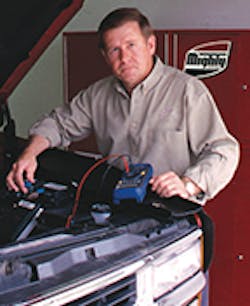When examining oil filters that are deformed from excessive pressure, filter gaskets blown or canister lock-seams unrolled, there is a reason for these conditions. While the oil filter is usually blamed for these conditions, the actual cause is over-pressurization due to a malfunction within the oil pump. Read on for pressurization issues involving GM, Kia and Hyundai.
Conditions Promoting Sticking Pressure Regulating Valves
- Plunger or bore wear.
- Imperfection in the valve bore.
- Sludge deposits due to poor maintenance schedule.
- Debris, restricting plunger travel.
- Metal fragments from machining or bearing wear.
- Removing gaskets with an abrasive disc produces fine grit that the oil filter may not be able to remove from the oil, resulting in engine damage or a sticking pressure regulating valve.
- A damaged or improperly sealed air filter can allow dust and debris to enter the combustion chambers and eventually into the crankcase causing bearing damage and oil pump regulating valve failure.
When sludge is present, research the maintenance service intervals of the engine. It is imperative the correct lubricant is installed when performing a vehicle service to prevent accelerated engine and component wear and the formation of sludge.
Failure to install an extended life oil filter on those applications driven for extended service intervals can promote premature engine/component failure. Conventional filters will not provide sufficient filtration for those extended service intervals, allowing filter bypass to occur. The bypass allows unfiltered/contaminated oil to be pumped throughout the engine.
Know Your Filter Supplier
The marketplace is filled with some bargain basement filters that you would not want on your engine. Make certain you select a quality filter from a reputable supplier. We have seen some of the bargain filters with drain back valves totally disintegrated and the silicone appearing residue restricting the oil passages causing accelerated engine wear and sticking pressure regulating valves, promoting high or no oil pressure conditions.Oil filter flow rates for the newer engines results in a higher pressure differential across the filter media, which requires a higher bypass valve setting. Filters that are not manufactured to these specs will result in unfiltered oil flowing through the engine, promoting accelerated engine component wear and oil pump failure.
GM Crankshaft Driven Oil Pump
In 2014, GM issued Service Bulletin No. 13314 affecting 2014 Chevrolet Silverado and GMC Sierra 1500 series trucks equipped with 5.3L V8 and 4.3L V6 engines. The vehicles were identified by VIN number in their Global Warranty Management System. The bulletin was to notify dealers the vehicles described may have an oil pump that was damaged during assembly and testing. The damage may result in the illumination of the malfunction indicator lamp and/or set diagnostic codes for a low oil pressure condition.While GM has used this style oil pump on certain engines since 1999, our GM contacts advise that most of the pumps currently being replaced involve applications between 2007-2013. The symptoms usually involve no oil pressure or a fluctuating oil pressure condition.
Another consideration is the O-ring that attaches the pick-up tube to the oil pump. If the O-ring that seals the pick-up tube to the oil pump fails to properly seal, a low, no or fluctuating oil pressure condition may occur. A defective seal is usually obvious when removing the pick-up tube from the oil pump, as the tube falls freely from the pump once the tube attachment bolt is removed during the oil pump removal.
The illustration reflects a typical GM crankshaft driven oil pump. A sticking pressure regulating valve has been a common occurrence, most often resulting in a loss of oil pressure.
AFM Filter Screen
Further, when considering a low oil pressure condition, be aware of a defective oil pressure sensor and a restriction in the active fuel management (AFM) filter screen, which is positioned beneath the oil pressure sensor. The filter screen often becomes restricted due to engine deposits/sludge restricting oil to the AFM hydraulic system and the oil pressure sensor. For more information, you can obtain a copy of Mighty Tech Tip No. 185 Low Oil Pressure Message… Locating the Mystery Filter.Kia, Hyundai Engine Recall
Kia and Hyundai are recalling nearly 1.5 million cars and SUVs in the US, Canada and South Korea due to potential engine failures that can result in the engine seizing and the risk of a crash, according to the National Highway Traffic Safety Administration.- Kia applications involve certain 2011- 2014 Optima, 2012-2014 Sorento and 2011-2013 Sportage vehicles.
- Hyundai applications involve certain 2013-2014 Sonata and Santa Fe Sport vehicles.
There’s More to the Story
There is more to the story than what has been described in the recall notice concerning engine failures. The industry has been plagued with oil pressure related symptoms on the mentioned Kia and Hyundai applications. At one point, Kia produced a bulletin that basically implied that only OE oil filters were compatible with their engines and the warranty would not be covered on engine failures where an aftermarket filter was installed. This prompted much response from the aftermarket filter suppliers, and it was addressed aggressively by the filter manufacturers, as it was not in compliance with the Magnuson Moss Warranty Act.While there was no mention from the vehicle manufacturers and NHTSA in the engine recall notice concerning under/over pressurization of the lubricating system, be advised the same metal fragments illustrated in the engine failures can restrict movement of the pressure regulating valve, which controls oil pressure. One minute fragment of metal can result in a catastrophic engine failure or an under or over oil pressurization condition.
About the Author

